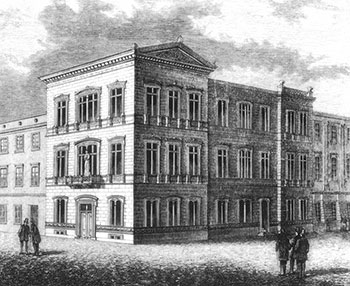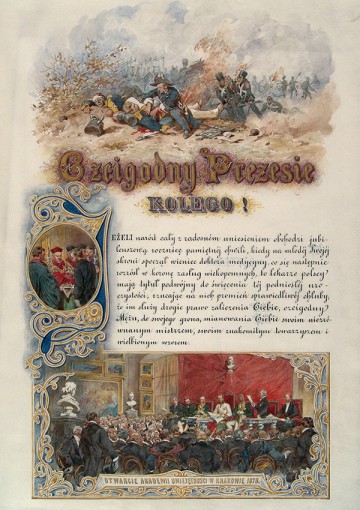|
|
|
|
Building of the Kraków Learned Society, |
From the past
The Academy of Arts and Sciences (AU) was established in 1872 as a result of the transformation of the Kraków Learned Society, which had existed since 1815. Though formally limited to the Austrian Partition, it served from the beginning as an all-Poland institute of culture and learning.
In keeping with the spirit of the society, its activities extended beyond the Austrian partition, and scholars from throughout Poland, and from many other countries, were active within it. That the Academy was given ownership (1893) of the building and collections of the Polish Library in Paris, the largest collection of Polish materials gathered by the Great Emigration, demonstrates that its influence extended beyond the borders of the partitions. Indeed, a branch of the Academy was established in Paris and an institution known as the Rome Expedition (annual research journeys to the Vatican archives) had already been functioning for some time.
|
|
|
|
Inauguration of the Academy of Arts and Sciences, |
Following WWI, the Academy took the name Polish Academy of Arts and Sciences (PAU) and became the official, national, state-supported representative of Polish learning, including – given that it was, for example, a founder member of Union Académique Internationale – in respect of international scientific organisations.
It was at its most active, particularly in publishing, in the inter-war period, when more than one-hundred series were issued, including the monumental Dictionary of Polish Biography.
The scope of its activities did not change after WWII until 1952, when the government of the day decided to take over its agencies and assets on behalf of the Polish Academy of Science (PAN) in Warsaw, which was just beginning its operations.
The Polish Academy of Arts and Sciences was not, however, dissolved. Indeed, following unsuccessful attempts at reactivation in 1956–1957 and 1980–1981, its activities were able to resume immediately after the systemic transformations of 1989.
Little time was lost in reconstituting its agencies and structures. First came the faculties. As a result of the automatic appointment to PAU of Kraków members of PAN, it was necessary to divide the Faculty of Mathematics and Natural Science. Consequently, as of May 1990, PAU had five Faculties: I – Linguistics; II – History and Philosophy; III – Mathematics-Physics-Chemistry; IV – Natural Science; V – Medicine. A sixth faculty, of the creative arts, was formed in March, 1993. As early as 1990, PAU resumed publishing. This began with the Yearbook of the Polish Academy of Arts and Science and the Transactions of the Polish Academy of Arts and Sciences. The structure of PAU’s arts and science commissions took shape from the bottom up – as needs, opportunities, and capacities allowed and dictated. The first of these was the Commission on Central Europe, which was formed in 1991.





